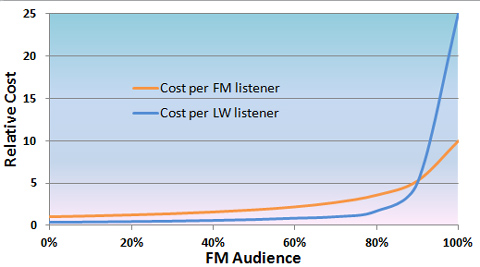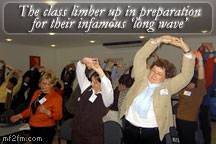The BBC recently reported that Radio Russia have quietly switched off the majority of their long-wave broadcast transmitters. Whilst the silent passing of Russia's long wave service will not rattle the front pages either in Russia or anywhere else for that matter, it does raise the question of the long-term viability of long-wave broadcasting.
 During the early 1990s there was a resurgence of interest in long-wave radio in the UK caused by the success of the pop station Atlantic 252. But by later in the decade, the poorer quality of long-wave broadcasting compared to FM, together with the increased proliferation of local FM services in the UK eventually led to the demise of the station. Similar logic appears to have been used by the Russian authorities who now have a much more extensive network of FM transmitters and clearly feel that the expense of operating long-wave is no longer justified.
During the early 1990s there was a resurgence of interest in long-wave radio in the UK caused by the success of the pop station Atlantic 252. But by later in the decade, the poorer quality of long-wave broadcasting compared to FM, together with the increased proliferation of local FM services in the UK eventually led to the demise of the station. Similar logic appears to have been used by the Russian authorities who now have a much more extensive network of FM transmitters and clearly feel that the expense of operating long-wave is no longer justified.
One of the great advantages of long-wave broadcasting is the large area that can be covered from a single transmitter. For countries whose population is spread over very wide areas, long-wave offers a means to broadcast to them with very few transmitters. Conversely, the large antennas and high transmitter powers required to deliver the service make it an expensive way to reach audiences. Presumably there is a relatively simple equation that describes the cost-benefit of long-wave broadcasting, i.e.:

Where:
As long as W>0 as A(FM) increases it continues to be worthwhile to broadcast on long-wave as the cost of providing the service is greater than the cost of doing the same thing using FM.
The cost of providing an FM service - C(FM) - is not constant, and will increase with the audience served, and not in a linear fashion either. The final few audience will cost significantly more than the first few. This is because stations which only serve small, sparse communities tend to be more costly (per person) than ones serving densely packed areas.
The cost of providing the LW service - C(LW) - however, is largely constant regardless of how many people listen to it.
It's therefore possible to draw a graph of the cost per person - C/A - of the FM audience and the cost per person of the long-wave audience, as the FM audience increases.

The figures used in the graph above are illustrative only. They assume that:
Of course there are many other factors to take into account, in particular the difference in service quality between FM and long-wave, and the proportion of receivers that have a long-wave function. There are thus other factors that will hasten the end of long-wave as FM coverage increases. The same could largely be said for medium-wave where arguably, the problems of night time interference make it even worse off than long-wave (though more receivers have it).
 Wireless Waffle reported back in 2006 on the various organisations planning to launch long-wave services, not surprisingly none of them have (yet) come to fruition.
Wireless Waffle reported back in 2006 on the various organisations planning to launch long-wave services, not surprisingly none of them have (yet) come to fruition.
There is, however, one factor in favour of any country maintaining a long-wave service (or even medium-wave for that matter), and it's this: simplicity. It is possible to build a receiver for long-wave (or medium-wave) AM transmissions using nothing more than wire and coal (and a pair of headphones) as was created by prisoners of war.
In the event (God forbid) of a national emergency that took electricity (such as a massive solar flare), it would still be possible for governments to communicate with their citizens using simple broadcasting techniques and for citizens to receive them using simple equipment. Not so with digital broadcasting! Ironically, most long-wave transmitters use valves which are much less prone to damage from solar flares than transistors.
So whilst long-wave services are on the way out in Russia and elsewhere, it will be interesting to see whether the transmitting equipment is completely dismantled at all sites, or whether some remain for times of emergency. Of course if every long-wave transmitter is eventually turned off, there is some interesting radio spectrum available that could be re-used for something else... offers on a postcard!
 During the early 1990s there was a resurgence of interest in long-wave radio in the UK caused by the success of the pop station Atlantic 252. But by later in the decade, the poorer quality of long-wave broadcasting compared to FM, together with the increased proliferation of local FM services in the UK eventually led to the demise of the station. Similar logic appears to have been used by the Russian authorities who now have a much more extensive network of FM transmitters and clearly feel that the expense of operating long-wave is no longer justified.
During the early 1990s there was a resurgence of interest in long-wave radio in the UK caused by the success of the pop station Atlantic 252. But by later in the decade, the poorer quality of long-wave broadcasting compared to FM, together with the increased proliferation of local FM services in the UK eventually led to the demise of the station. Similar logic appears to have been used by the Russian authorities who now have a much more extensive network of FM transmitters and clearly feel that the expense of operating long-wave is no longer justified.One of the great advantages of long-wave broadcasting is the large area that can be covered from a single transmitter. For countries whose population is spread over very wide areas, long-wave offers a means to broadcast to them with very few transmitters. Conversely, the large antennas and high transmitter powers required to deliver the service make it an expensive way to reach audiences. Presumably there is a relatively simple equation that describes the cost-benefit of long-wave broadcasting, i.e.:

Where:
W = Worthwhileness of Long-Wave Broadcasting
C = Total cost of providing the service
A = Audience
FM = FM
LW = Long Wave
Tot = Total
C = Total cost of providing the service
A = Audience
FM = FM
LW = Long Wave
Tot = Total
As long as W>0 as A(FM) increases it continues to be worthwhile to broadcast on long-wave as the cost of providing the service is greater than the cost of doing the same thing using FM.
The cost of providing an FM service - C(FM) - is not constant, and will increase with the audience served, and not in a linear fashion either. The final few audience will cost significantly more than the first few. This is because stations which only serve small, sparse communities tend to be more costly (per person) than ones serving densely packed areas.
The cost of providing the LW service - C(LW) - however, is largely constant regardless of how many people listen to it.
It's therefore possible to draw a graph of the cost per person - C/A - of the FM audience and the cost per person of the long-wave audience, as the FM audience increases.

The figures used in the graph above are illustrative only. They assume that:
- The cost per person of providing an FM service increases by a factor of 10 between the first and the last person served;
- The cost per person of providing the long-wave service is initially only a third of that of providing the same service on FM.
Of course there are many other factors to take into account, in particular the difference in service quality between FM and long-wave, and the proportion of receivers that have a long-wave function. There are thus other factors that will hasten the end of long-wave as FM coverage increases. The same could largely be said for medium-wave where arguably, the problems of night time interference make it even worse off than long-wave (though more receivers have it).
 Wireless Waffle reported back in 2006 on the various organisations planning to launch long-wave services, not surprisingly none of them have (yet) come to fruition.
Wireless Waffle reported back in 2006 on the various organisations planning to launch long-wave services, not surprisingly none of them have (yet) come to fruition. There is, however, one factor in favour of any country maintaining a long-wave service (or even medium-wave for that matter), and it's this: simplicity. It is possible to build a receiver for long-wave (or medium-wave) AM transmissions using nothing more than wire and coal (and a pair of headphones) as was created by prisoners of war.
Prisoners of war during WWII had to improvise from whatever bits of junk they could scrounge in order to build a radio. One type of detector used a small piece of coke, which was a derivative of coal often used in heating stoves, about the size of a pea.
After much adjusting of the point of contact on the coke and the tension of the wire, some strong stations would have been received.
If the POW was lucky enough to scrounge a variable capacitor, the set could possibly receive more frequencies.
Source: www.bizzarelabs.com
In the event (God forbid) of a national emergency that took electricity (such as a massive solar flare), it would still be possible for governments to communicate with their citizens using simple broadcasting techniques and for citizens to receive them using simple equipment. Not so with digital broadcasting! Ironically, most long-wave transmitters use valves which are much less prone to damage from solar flares than transistors.
So whilst long-wave services are on the way out in Russia and elsewhere, it will be interesting to see whether the transmitting equipment is completely dismantled at all sites, or whether some remain for times of emergency. Of course if every long-wave transmitter is eventually turned off, there is some interesting radio spectrum available that could be re-used for something else... offers on a postcard!
1 comment
( 2544 views )
| permalink
| 



 ( 2.9 / 1848 )
( 2.9 / 1848 )




 ( 2.9 / 1848 )
( 2.9 / 1848 )

